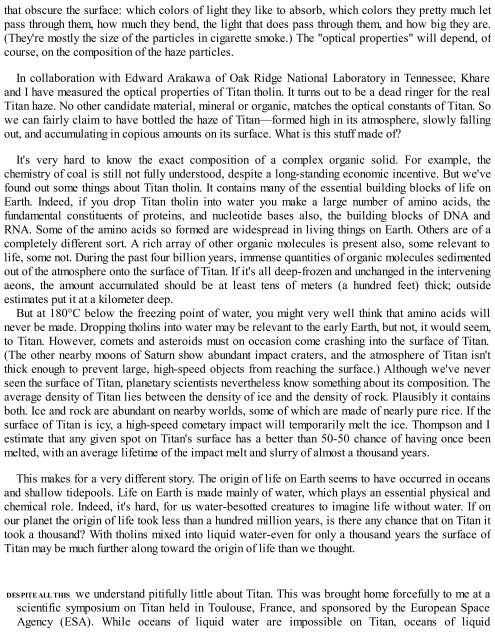Pale Blue Dot ( PDFDrive.com ) (1)
You also want an ePaper? Increase the reach of your titles
YUMPU automatically turns print PDFs into web optimized ePapers that Google loves.
that obscure the surface: which colors of light they like to absorb, which colors they pretty much let<br />
pass through them, how much they bend, the light that does pass through them, and how big they are.<br />
(They're mostly the size of the particles in cigarette smoke.) The "optical properties" will depend, of<br />
course, on the <strong>com</strong>position of the haze particles.<br />
In collaboration with Edward Arakawa of Oak Ridge National Laboratory in Tennessee, Khare<br />
and I have measured the optical properties of Titan tholin. It turns out to be a dead ringer for the real<br />
Titan haze. No other candidate material, mineral or organic, matches the optical constants of Titan. So<br />
we can fairly claim to have bottled the haze of Titan—formed high in its atmosphere, slowly falling<br />
out, and accumulating in copious amounts on its surface. What is this stuff made of?<br />
It's very hard to know the exact <strong>com</strong>position of a <strong>com</strong>plex organic solid. For example, the<br />
chemistry of coal is still not fully understood, despite a long-standing economic incentive. But we've<br />
found out some things about Titan tholin. It contains many of the essential building blocks of life on<br />
Earth. Indeed, if you drop Titan tholin into water you make a large number of amino acids, the<br />
fundamental constituents of proteins, and nucleotide bases also, the building blocks of DNA and<br />
RNA. Some of the amino acids so formed are widespread in living things on Earth. Others are of a<br />
<strong>com</strong>pletely different sort. A rich array of other organic molecules is present also, some relevant to<br />
life, some not. During the past four billion years, immense quantities of organic molecules sedimented<br />
out of the atmosphere onto the surface of Titan. If it's all deep-frozen and unchanged in the intervening<br />
aeons, the amount accumulated should be at least tens of meters (a hundred feet) thick; outside<br />
estimates put it at a kilometer deep.<br />
But at 180°C below the freezing point of water, you might very well think that amino acids will<br />
never be made. Dropping tholins into water may be relevant to the early Earth, but not, it would seem,<br />
to Titan. However, <strong>com</strong>ets and asteroids must on occasion <strong>com</strong>e crashing into the surface of Titan.<br />
(The other nearby moons of Saturn show abundant impact craters, and the atmosphere of Titan isn't<br />
thick enough to prevent large, high-speed objects from reaching the surface.) Although we've never<br />
seen the surface of Titan, planetary scientists nevertheless know something about its <strong>com</strong>position. The<br />
average density of Titan lies between the density of ice and the density of rock. Plausibly it contains<br />
both. Ice and rock are abundant on nearby worlds, some of which are made of nearly pure rice. If the<br />
surface of Titan is icy, a high-speed <strong>com</strong>etary impact will temporarily melt the ice. Thompson and I<br />
estimate that any given spot on Titan's surface has a better than 50-50 chance of having once been<br />
melted, with an average lifetime of the impact melt and slurry of almost a thousand years.<br />
This makes for a very different story. The origin of life on Earth seems to have occurred in oceans<br />
and shallow tidepools. Life on Earth is made mainly of water, which plays an essential physical and<br />
chemical role. Indeed, it's hard, for us water-besotted creatures to imagine life without water. If on<br />
our planet the origin of life took less than a hundred million years, is there any chance that on Titan it<br />
took a thousand? With tholins mixed into liquid water-even for only a thousand years the surface of<br />
Titan may be much further along toward the origin of life than we thought.<br />
DESPITE ALL THIS we understand pitifully little about Titan. This was brought home forcefully to me at a<br />
scientific symposium on Titan held in Toulouse, France, and sponsored by the European Space<br />
Agency (ESA). While oceans of liquid water are impossible on Titan, oceans of liquid


